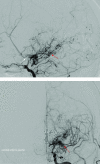Natural history of Myhre syndrome
- PMID: 35907855
- PMCID: PMC9338657
- DOI: 10.1186/s13023-022-02447-x
Natural history of Myhre syndrome
Abstract
Background: Myhre syndrome (MS) is a rare genetic disease characterized by skeletal disorders, facial features and joint limitation, caused by a gain of function mutation in SMAD4 gene. The natural history of MS remains incompletely understood.
Methods: We recruited in a longitudinal retrospective study patients with molecular confirmed MS from the French reference center for rare skeletal dysplasia. We described natural history by chaining data from medical reports, clinical data warehouse, medical imaging and photographies.
Results: We included 12 patients. The median age was 22 years old (y/o). Intrauterine and postnatal growth retardation were consistently reported. In preschool age, neurodevelopment disorders were reported in 80% of children. Specifics facial and skeletal features, thickened skin and joint limitation occured mainly in school age children. The adolescence was marked by the occurrence of pulmonary arterial hypertension (PAH) and vascular stenosis. We reported for the first time recurrent strokes from the age of 26 y/o, caused by a moyamoya syndrome in one patient. Two patients died at late adolescence and in their 20 s respectively from PAH crises and mesenteric ischemia.
Conclusion: Myhre syndrome is a progressive disease with severe multisystemic impairement and life-threathning complication requiring multidisciplinary monitoring.
© 2022. The Author(s).
Conflict of interest statement
The authors declare no conflicts of interest.
Figures



References
-
- Le Goff C, Mahaut C, Abhyankar A, Le Goff W, Serre V, Afenjar A, Destrée A, di Rocco M, Héron D, Jacquemont S, Marlin S, Simon M, Tolmie J, Verloes A, Casanova J-L, Munnich A, Cormier-Daire V. Mutations at a single codon in Mad homology 2 domain of SMAD4 cause Myhre syndrome. Nat Genet. 2011;44:85–88. doi: 10.1038/ng.1016. - DOI - PubMed
-
- Michot C, Le Goff C, Mahaut C, Afenjar A, Brooks AS, Campeau PM, Destree A, Di Rocco M, Donnai D, Hennekam R, Heron D, Jacquemont S, Kannu P, Lin AE, Manouvrier-Hanu S, Mansour S, Marlin S, McGowan R, Murphy H, Raas-Rothschild A, Rio M, Simon M, Stolte-Dijkstra I, Stone JR, Sznajer Y, Tolmie J, Touraine R, van den Ende J, Van der Aa N, van Essen T, Verloes A, Munnich A, Cormier-Daire V. Myhre and LAPS syndromes: clinical and molecular review of 32 patients. Eur J Hum Genet EJHG. 2014;22:1272–1277. doi: 10.1038/ejhg.2013.288. - DOI - PMC - PubMed
-
- Caputo V, Cianetti L, Niceta M, Carta C, Ciolfi A, Bocchinfuso G, Carrani E, Dentici ML, Biamino E, Belligni E, Garavelli L, Boccone L, Melis D, Andria G, Gelb BD, Stella L, Silengo M, Dallapiccola B, Tartaglia M. A restricted spectrum of mutations in the SMAD4 tumor-suppressor gene underlies Myhre syndrome. Am J Hum Genet. 2012;90:161–169. doi: 10.1016/j.ajhg.2011.12.011. - DOI - PMC - PubMed
MeSH terms
Substances
Supplementary concepts
LinkOut - more resources
Full Text Sources
Miscellaneous

